Cervezas, Sábalos, y Desayunos Salvajes - Seis Dias en Tabasco México
¡Me llamaron brazos de chilaquiles!
Each day we launched the two pangas near the mouth of the lesser, easternmost channel of the Usumacinta River in Tabasco Mexico. It is muddy and almost a thousand feet wide here and you can see the Gulf of Mexico. Mature and impenetrable mangrove forests line the banks for several miles inland and creep up every side channel and surround huge, hidden lagoons miles away from the main flow. This river establishes the border between Tabasco and Campeche states, then between Tabasco and Chiapas, then between Chiapas and Guatemala. The headwaters of the Usumacinta reach nearly to the top of the Guatemalan Highlands, well over 10,000’, and start less than fifty miles from the Pacific Ocean to the south.
The seasonal brackish water ends a few miles up the Usumacinta and so do the mangroves. The banks then are mostly solid ground but they flood every year for a few months. This entire area was once covered in a freshwater swamp forest, some of it still exists and is a mix of logwood, black olive, mahogany, gumbo-limbo, and cedar. But near the river it has been mostly cleared by humans, on and off, for thousands of years, for agriculture and grazing. Now it’s a wide open flood plain, perfectly flat and clear to the horizon, dotted with the distinctive crowns of solitary palm and ceiba trees, the latter important to the Maya, connecting the underworld to this world and to the heavens, it’s form distinctive when grown in isolation - a massively thick trunk and an even, well-organized branching pattern tapering to perfectly fine tips and a smoothly rounded canopy - it is a good representation of a phylogenetic tree - a taxonomically Malvaceous representation of taxonomy itself.
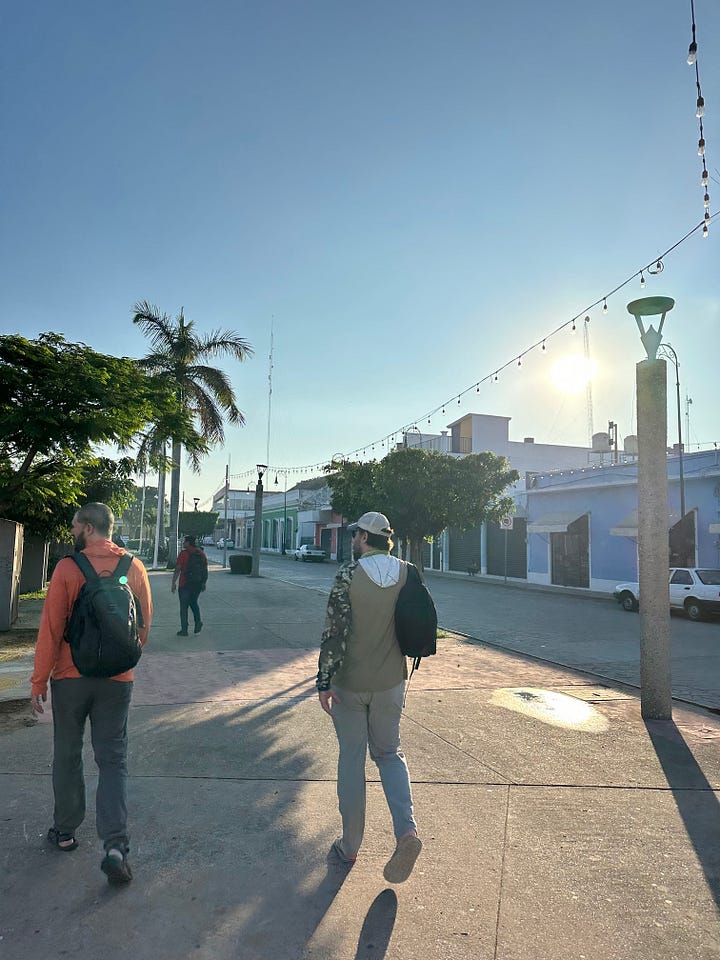
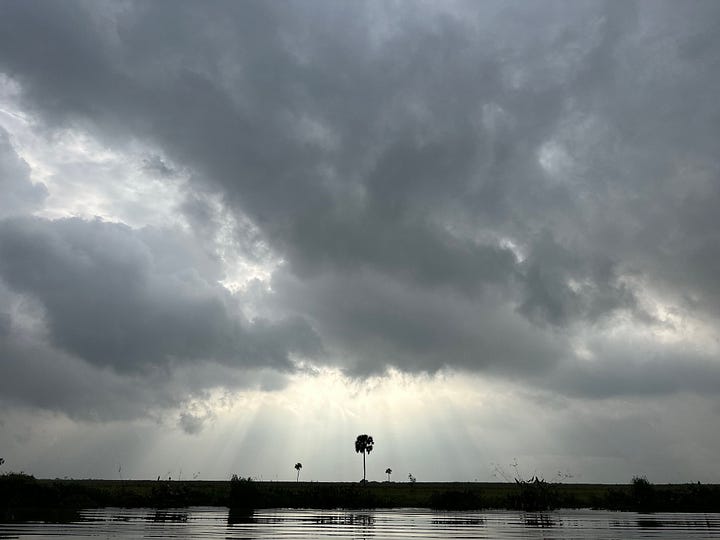
The first two days we spent with Paco and Raúl from Tabasco Fly Fishing were on a mangrove lined side channel that wound its way, after a mile or so, to a mangrove encircled lagoon, maybe half a mile in diameter, with wavy creek arms radiating out from around its circumference - on the satellite view it looks like a wonky drawing of a trippy green sun with a dark blue core. They called this Laguna del Cometa, but it is nameless on Google Maps and there are other lagoons with this name in Los Pantanos de Centla.
There were rolling tarpon in every riverbend and then throughout the entire lagoon - they roamed like packs of tiny silver wolves across the open water. The day Ryan and I shared a boat we spent nearly four hours inching through the middle of the lagoon throwing foam gurglers. Paco would anchor us, stern to the wind, and we’d fan cast an area for ten or fifteen minutes and have a few fish explode on the fly in each spot, sometimes a dozen fish, and then he’d push us another fifty feet and we’d do it again. The average size fish we saw here was pretty small, but apparently they do get bigger fish in this area from time to time. Non-stop action on gurglers makes the size less relevant and honestly, landing a ten-plus pound tarpon on an 8wt hurts my forearm. ¡Me llamaron brazos de chilaquiles! ¡Que pinche cabrones!
Paco felt very strongly about how to properly retrieve a gurgler, and while I was resistant at first, I always want to chug that dang thing, of course he knew best and it did seem to work better. He insisted that you only chug it once or twice to get their attention, then you want to very evenly and slowly slide the fly along the surface of the water with as minimal disruption as possible. Those little fuckers will see it. There were times when four or five or six fish would try to grab the fly on one presentation, slashing and splashing and flipping and occasionally getting hooked. I was repeatedly admonished for trout setting, of course, but I still managed to stick my share of tarpon.
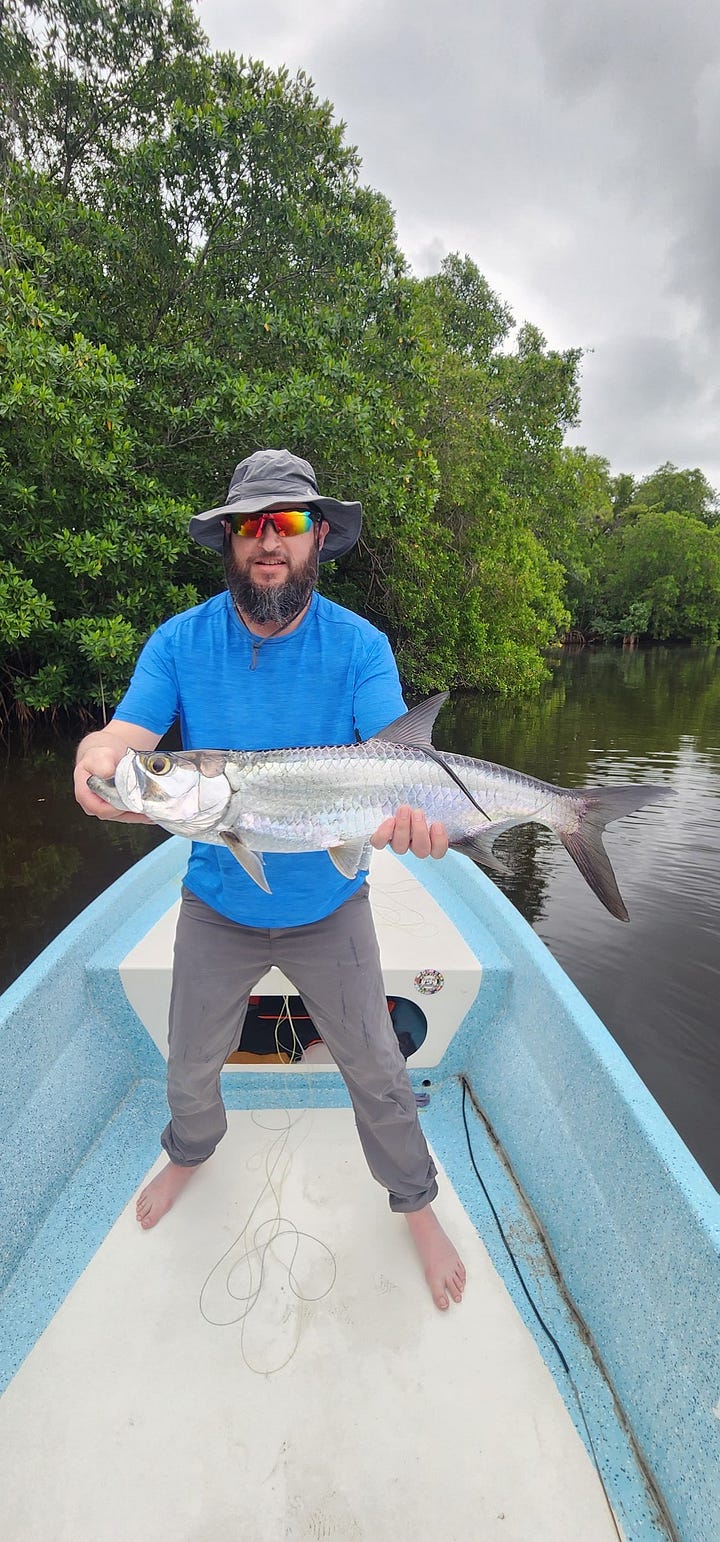
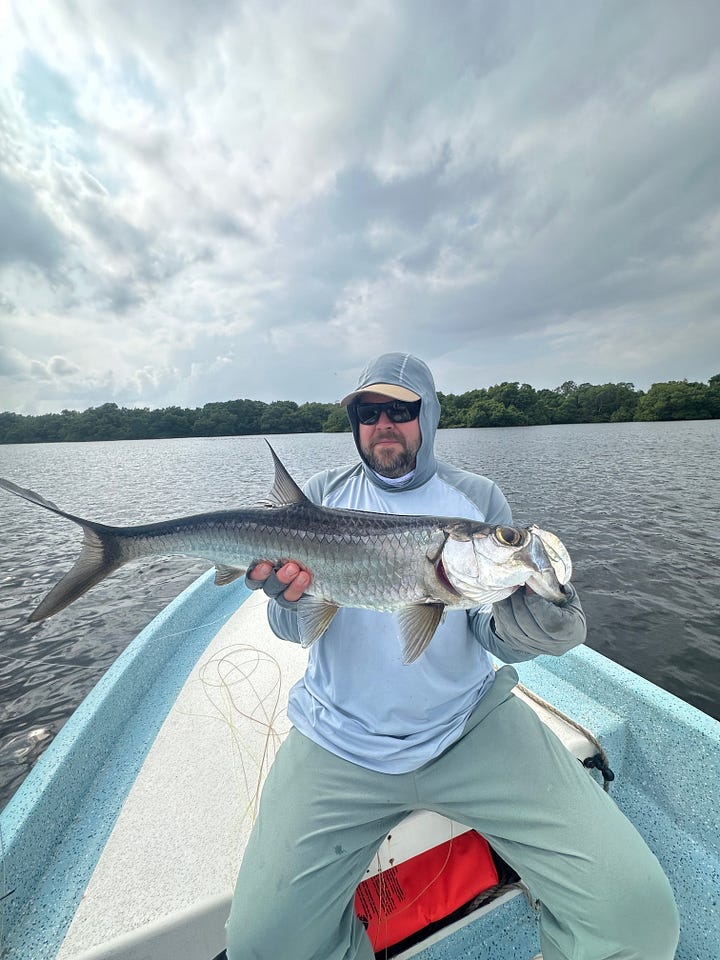
A lot of the main river’s floodplain is dissected by fences, some made with weathered gray milled lumber, some with crooked branches from the closest trees. There were cattle and water buffalo scattered throughout the pastures. Around one bend there was a single donkey silhouetted against the gray sky, perfectly still, its mane blowing stiffly in the warm wind. There are occasional ramshackle squatter huts, most slapped together from corrugated metal panels, sticks woven together to form walls, thatched palm roofs. There are sturdier buildings, too, and maybe some legal settlements, made of concrete block next to large metal corrals, several men riding horses, saddled horses tied to trees - La Cabeza de Vaca - the name given to one ranch because there’s a bull skull painted orange and nailed to a cross member on the wooden cattle chute-cum-pier that juts out into the river to a moored floating barn barge. Despite how destitute some of the residents of these settlements appear, the denizens of La Cabeza de Vaca seemed to be doing just fine.
At one point on the east bank of the river I noticed some large, oddly boxy pyramid shapes rising fifty or so feet above the floodplain covered in grass and thinly populated with trees. Paco said, “those are Mayan ruins. It was an outpost, a place to stop on long journeys between cities.” Two very famous Mayan sites are located upriver in the state of Chiapas - Palenque and Bonampak - which together contain some of the finest architecture, sculpture, and murals known from the entire Mayan world.
This part of the Usumacinta River kind of looks like the Okavango Delta in Botswana, or so we supposed because none of us have actually been to Botswana. We were half expecting to see an elephant or a pride of lions. There was a chance to see a tapir or a jaguar, but they eluded us. We did, however, encounter howler monkeys a couple times. In one meeting with them a big alpha male climbed to the top of the highest tree while the rest of his group fled into the jungle. He howled at us for about five minutes, a truly terrifying and loud scream. Paco said that if we got too close to him he’d throw his poop at us.
In addition to tapir, jaguar, and monkeys, there are also crocodiles, coral snakes, and coatimundi here. Paco said that Americans love calling them coatimundos for some reason. They are related to racoons and apparently pretty widespread throughout Mexico and even into the desert southwest in the US. Paco claims that coatimundi are mean, especially when they’re breeding, and that a few years ago a local man had his leg completely torn off by one, which seems a little hard to believe, but I’ve never fought one so what do I know?
The Pantanos de Centla is a 6,600 square mile wetland that is made up of the deltas of both the Usumacinta and Grijalva Rivers. It’s the second biggest wetlands in North America, smaller only than the Everglades. About one third of this area has been explicitly protected from development and natural resource extraction since 2006. While it is an incredible baby tarpon fishery, which attracts your average UPF 50+ hoodie clad dentists and doctors et al. from the states to whip their eight weights around (it me!), amongst Mexican sport fisherman it is primarily known as a snook fishery where 20lb fish are not uncommon and 30lb fish are caught with some regularity. The snook fishing has apparently improved over the last several years since commercial fishing regulations have become more restrictive - you can no longer string a net across the entire width of the river.
Big snook are hard to target on the fly here as they’re usually deep and not well concentrated in any particular area, but you can get lucky. Trolling stick baits is the typical approach. Paco’s father, Paco Marroquin Senior, is a famous snook fisherman in Mexico and used to host a nationally televised fishing show called Vamonos de Pesca which was important in popularizing sport fishing in Mexico. We caught a few snook on the fly during our three days of fishing, but nothing large.
On our last day as we were running up the river in the morning Paco spotted some activity in an eddy on the far bank and immediately cut the engine and yelled at me “Snook! Snook! Big Snook! Get ready get ready get ready!” I jumped up from my seat and fumbled with the 9wt to loose the fly and strip line and it was tangled with the second rod and Paco was still yelling, “Big snook! Big snook!” I managed to get everything clear and strip out line without it tangling and I hoisted myself up on the front deck as the boat was still gliding towards the bank on its silent inertia and I even managed to make a good cast on the first try, one of maybe seventy or eighty feet, and I let the fly sink until Paco said “OK” and then I made slow, short strips and there was an eruption of water near my fly and I swept the rod hard to the side and then another eruption and I swept the rod again and Paco yelled at me “Trout set! AHHHHH! Come on man! Buck fever!” I yelled back at him, “you’re the one giving me buck fever dude - we’re ripping up this river at 40mph for twenty minutes enjoying the scenery and then you’re yelling at me to cast at a giant snook! Hahaha!” And he laughed too and that was the only real shot we had at a big snook and apparently that’s how it usually happens.
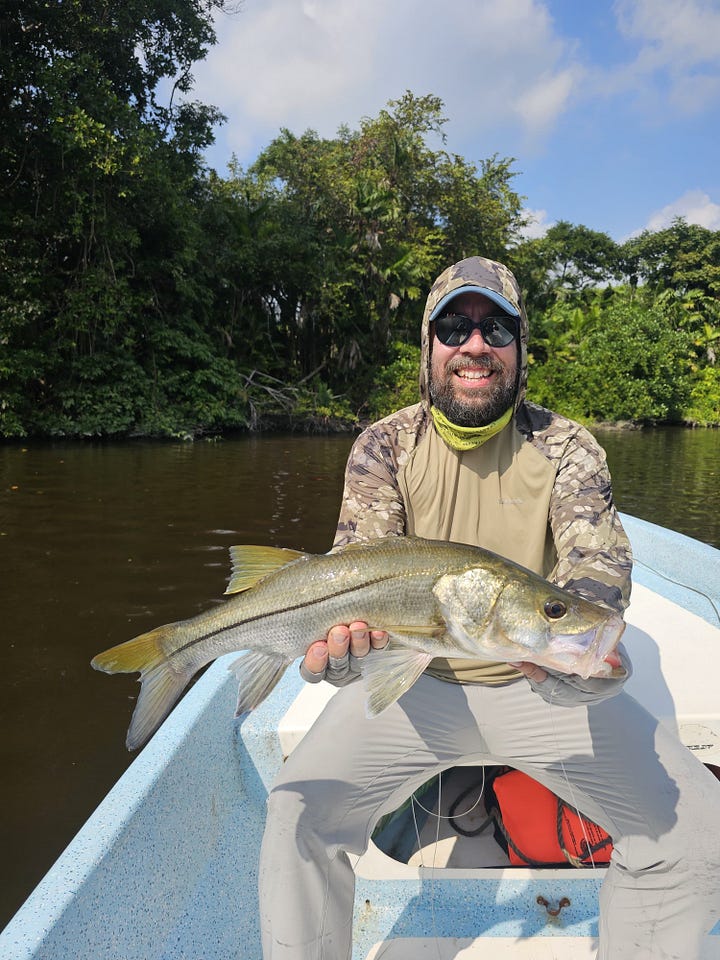
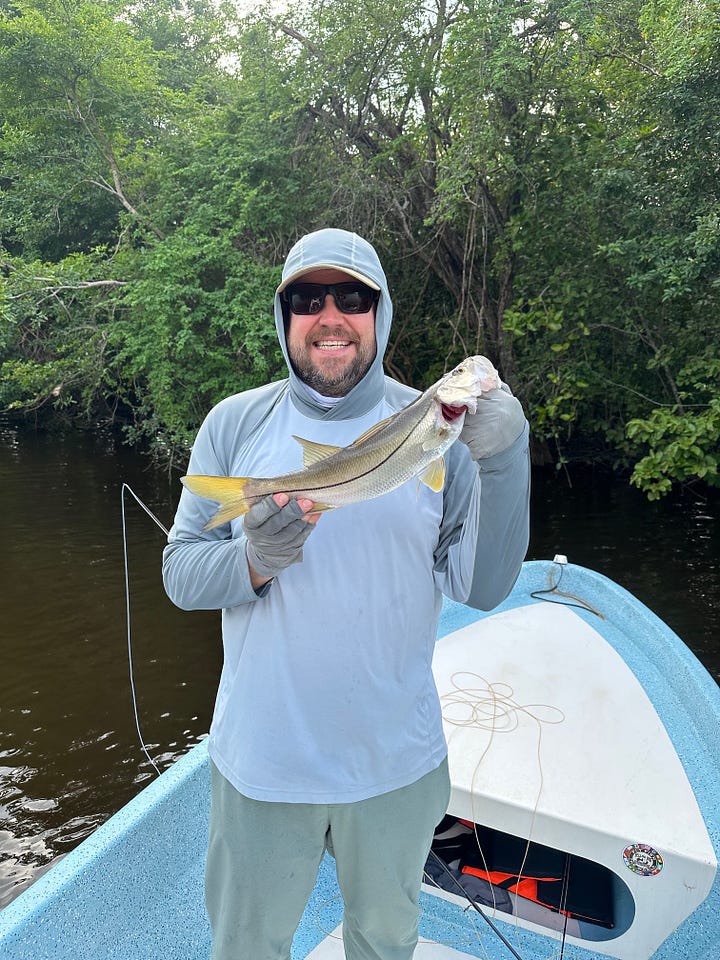
The town at the mouth of the Usumacinta River is called Frontera, about an hour and a half drive northeast of the biggest city in Tabasco, Villahermosa. Frontera is the only town of any size in the Pantanos de Centla and was recently named a Pueblo Mágico, a Magic Town, by the Mexican government, which is a program that selects usually small and rural communities that have a special tradition, food, or some other significance to highlight for tourism and development. Hopefully this will pump some money and broader perspective into this very safe, welcoming, though quite provincial and rough-around-the-edges town.
Frontera is recognized as a Pueblo Mágico for the Pantanos de Centla generally, but also specifically for their local specialty dish, ceviche blanco, made with, of course, snook. Paco took us to Restaurante ModeLuis for this dish specifically. The fish is very finely chopped or pulled, so much so that it appears to be mushy on the plate, more like a dip than ceviche, but I was pleasantly surprised that it maintains a very fine, delicate, firm texture and the experience was anything but mushy, though it is particularly easy to eat with chips and crackers. In fact it was quite a sharp experience with, of course, the lime marinade, but also with a thin green habanero salsa served on the side that was very spicy and quite flavorful. Ed Currie, the inventor of the Carolina Reaper, often says that habaneros are flavorless. I can’t possibly imagine that he’s spent much time in southeast Mexico.
I was disappointed to learn that there were no bars or restaurants that serve alcohol on the large and attractive city square in Frontera. It seems this is potentially fallout from the Magic Town designation - to protect the children - I was told. Needless to say I hate this kind of attitude - drinking beer can be part of a healthy, positive lifestyle, dammit. I think this must be a local decision reflecting their specific views on alcohol because there are over 150 magic towns in Mexico and most don’t seem to have this restriction.
There are a couple bars in town, away from the square of course, and there is a walk-up convenience store about three blocks east of the square where you can buy beer and chips and cigarettes through a window from the sidewalk. Raúl took us there and showed us a picture of his last two clients buying beer through the window while Ryan bought two six packs of tall yellow Pacifico cans. Raúl said something to the clerk and was presented with a long cardboard box, like a box set of baseball cards, that held ten or fifteen open packs of cigarettes. He selected a single cigarette and paid a five peso coin. I exclaimed, “Oh damn! Raúl bought a loosie!” He held it up, confusingly proud with raised eyebrows, and I said, “En inglés llamamos eso un suelto, un sueltito.”
Raúl pursed his lips a bit, nodding in understanding but hugely unimpressed, “Aqui tambien, un cigarro suelto.” And that was the second best piece of Spanish we learned on the trip.
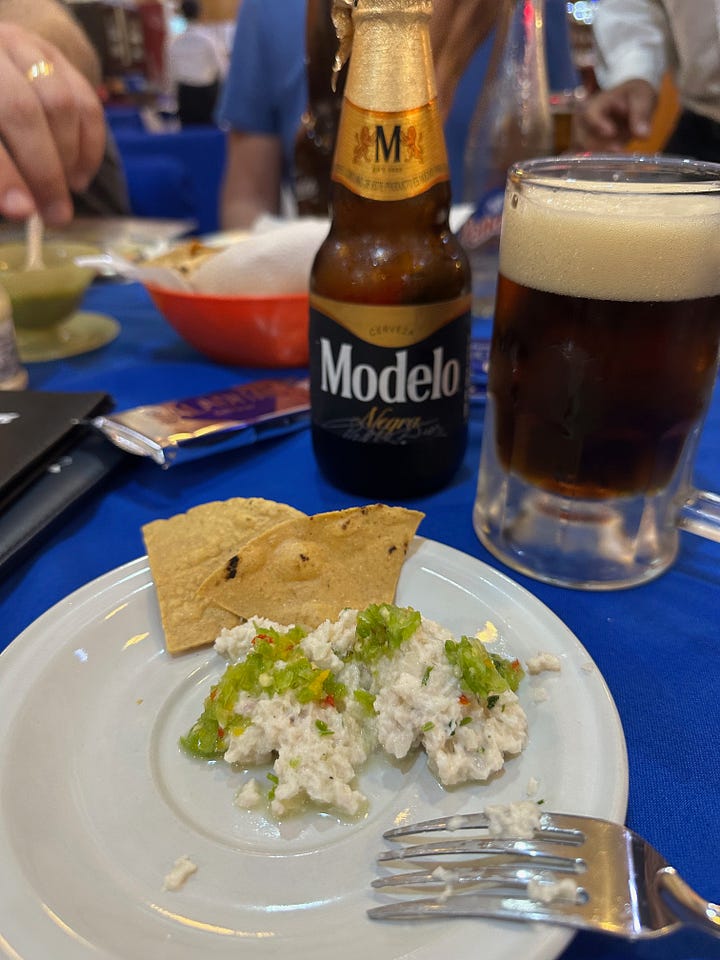
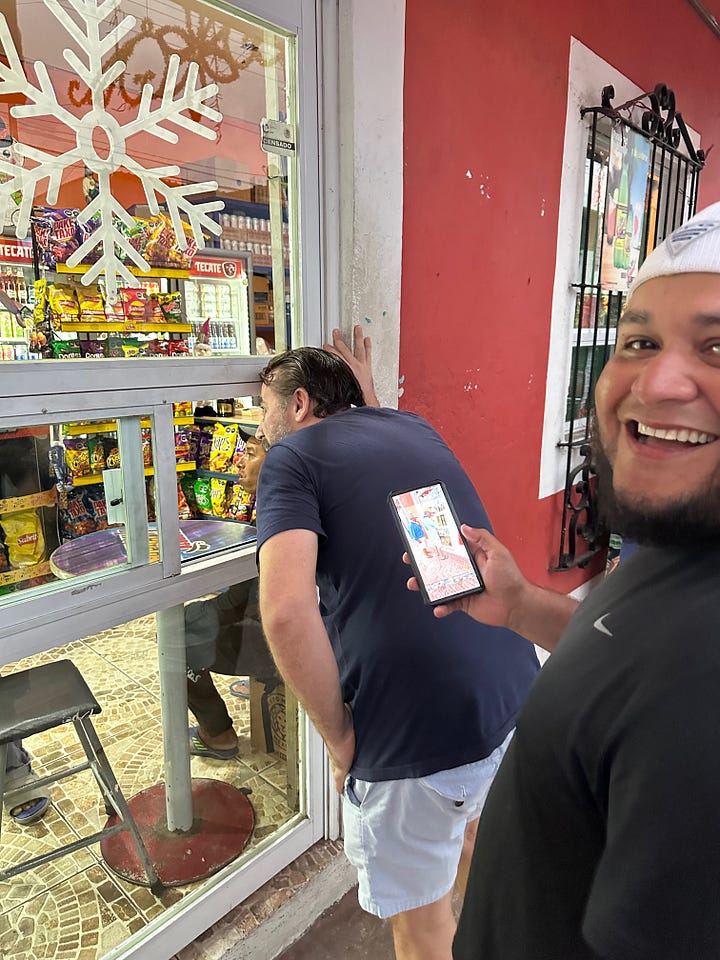
We took our cans of beer to the taco shop on the north side of the square where a giant trompo was turning on its spit just inside the building off the sidewalk and asked if we could drink beers while we ate. They don’t sell beer but it wasn’t a problem for us to drink the beer we brought, the wide eyed, energetic older hostess told us, fanning at us with menus toward a table on the street, which surprised us because of the whole Pueblos Mágicos thing, but this is Mexico after all: tons of rules, randomly enforced. She told me to stack two plastic patio chairs together because I was going to break just the one. The tacos were good, particularly the Campechano, a mix of longaniza sausage and beef, and the al pastor from the trompo - “y con todos” - with everything - cilantro, onions, and pickled carrots on the side.
We offered Raúl a beer and Paco said he doesn’t drink anymore, that he had a problem with it. “He’s like Stifler from American Pie,” Paco said, and that reference was lost on me because I couldn’t remember if Stifler was a bad drunk or something, but Chris said, “He’s like Stifler? Then we want to meet his mom.”
There was a small convenience store shack located across the street from the boat launch that sold cold beer. Drinking while riding in a car is one of our favorite things to do in Mexico so we started each evening at the boat launch with a cold twelve pack of Modelo Especial. Chris, Ryan, and myself drank thirty-some beers that second night - in the car, at the taco spot, in the dusty, seemingly never-used top floor event space of the hotel where we couldn’t find the light switches so we sat in the dim reflection of the hallway lights near the large open windows where the sounds and the colorful pale lights of the town square rolled in with the humid ocean air.
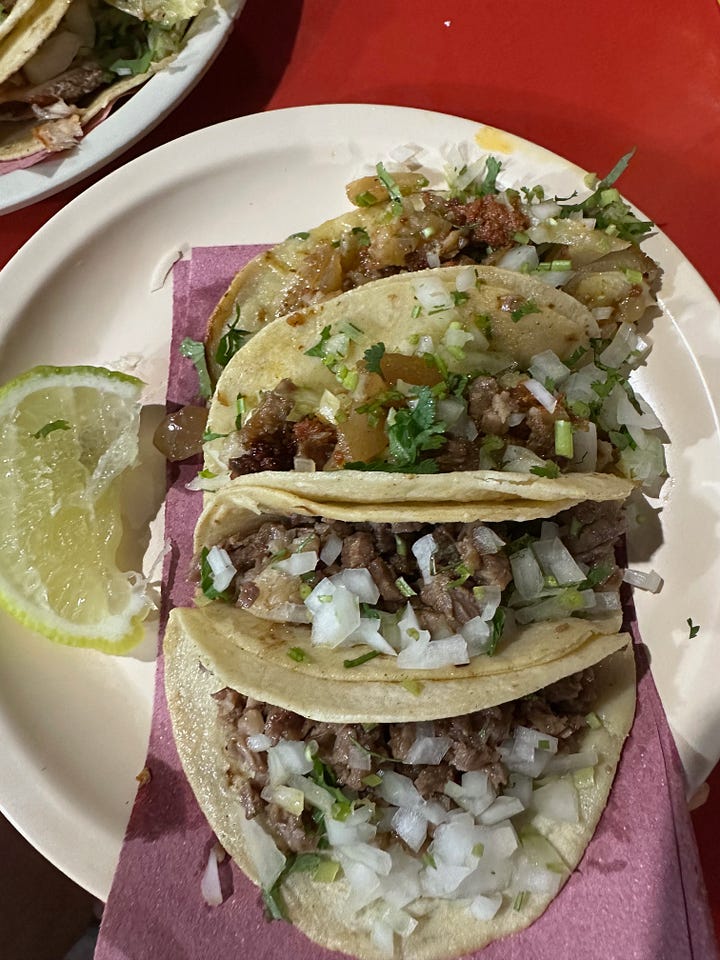
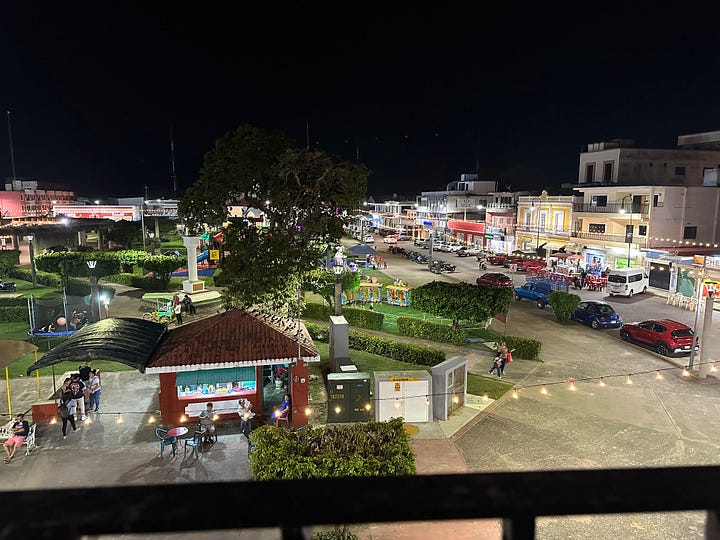
We focused philosophically on a few related, well worn topics this trip, as well worn as the cogito, for example, though we did have a breakthrough - Chris finally admitted, reluctantly, that he is self aware and that it is impossible to doubt, though he was also happy to derail this line of inquiry with what it might mean for AI to be self aware. We also spent a lot of time discussing our new President who took office on our second day of fishing, oddly on Martin Luther King day. I think Chris’ statement from one blurry night sums up something, though I know not what - “War is hell. Thank god for oceans.”
It’s too deep in Los Pantanos for push poles. The big pangas at Tabasco Fly Fishing are maneuvered with rudimentary narrow-bladed wooden paddles with straight shafts and no handles. Paco and Raúl are good at it, even in the wind and current. They also deploy anchors, either from the stern or the bow depending on the wind direction. The brand new Suzuki four stroke outboards contrasted starkly with the wooden paddles, the rusty anchors, and the trash strewn mud lot where the boats are launched every morning on a small creek in the mangroves a few hundred feet from the main river.
There is a woman who tends the boat launch with her young son - and they might live there, it wasn’t clear. They watch the boats, wash down rods and reels and stow everything safely inside at night and bring it out the next morning. It’s nice to not have to mess with tackle every day. Paco told us we could directly tip her if and when we wanted, because it was only her and her son. The folks at the hotel and the restaurant where we had breakfast every morning should be tipped through Paco at the end of the trip so he could fairly distribute the money. In the past they’ve fought about it. Last year the dock woman’s son almost died of kidney disease. The local Mormons, of which there are increasing numbers in the area, raised $2,000 US for his care.
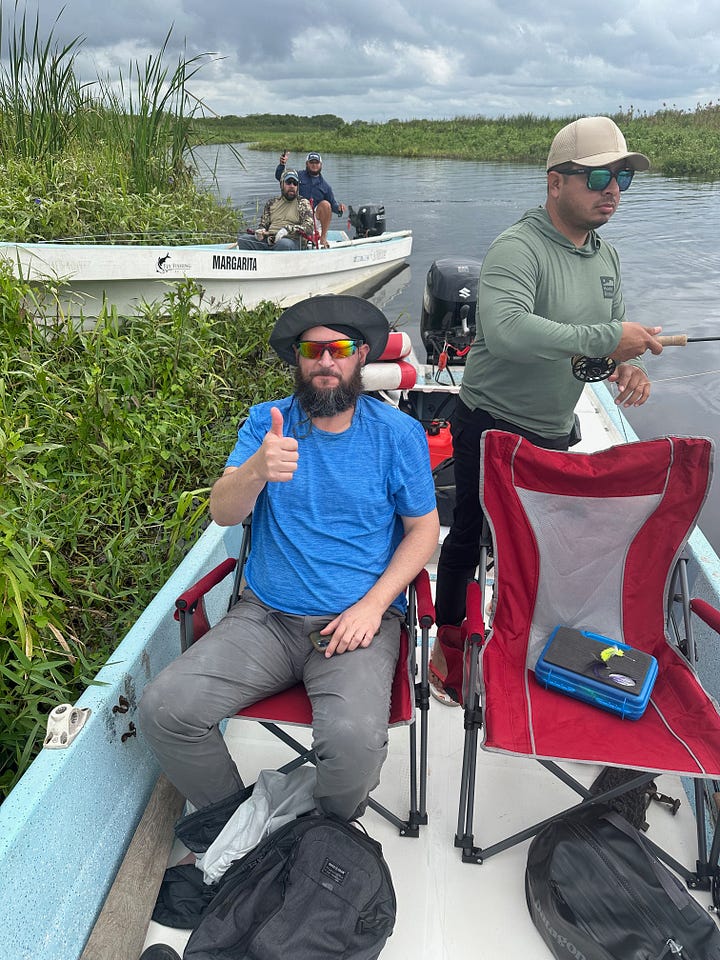
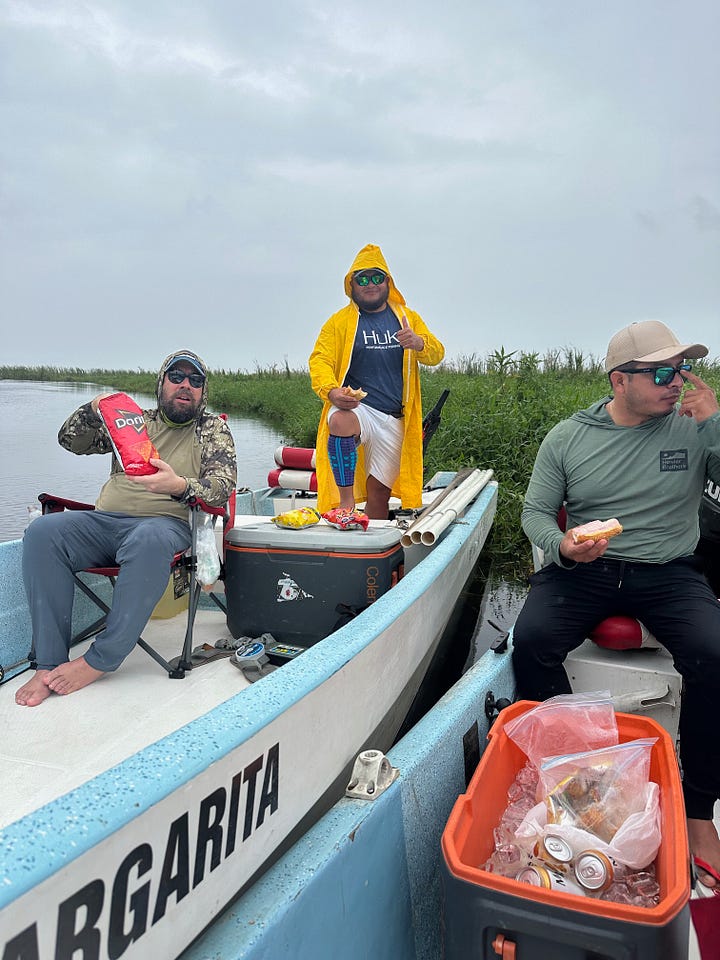
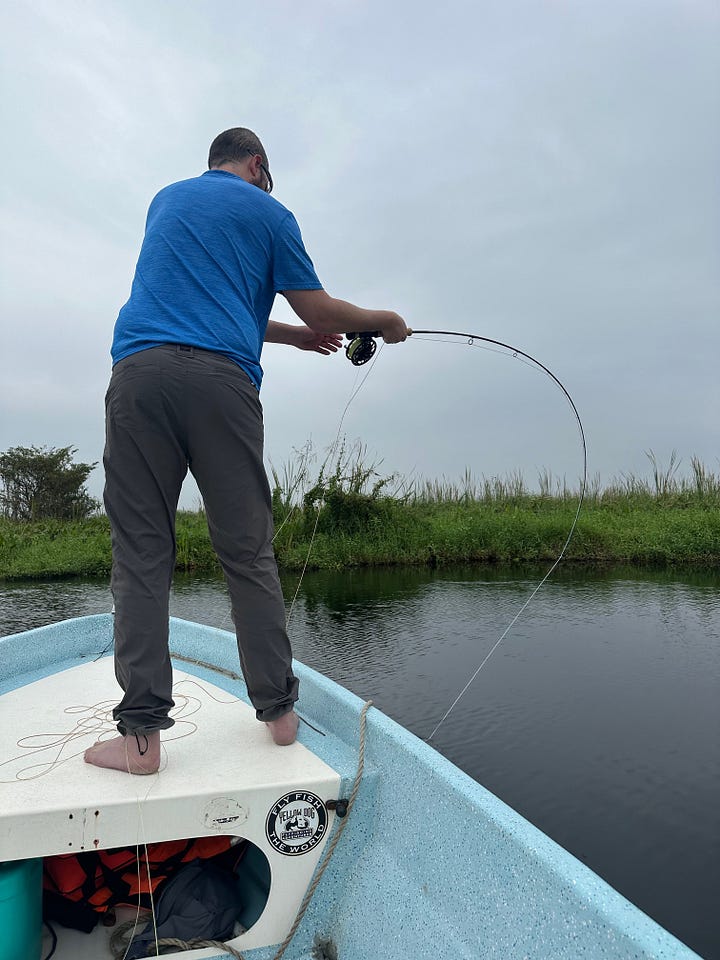
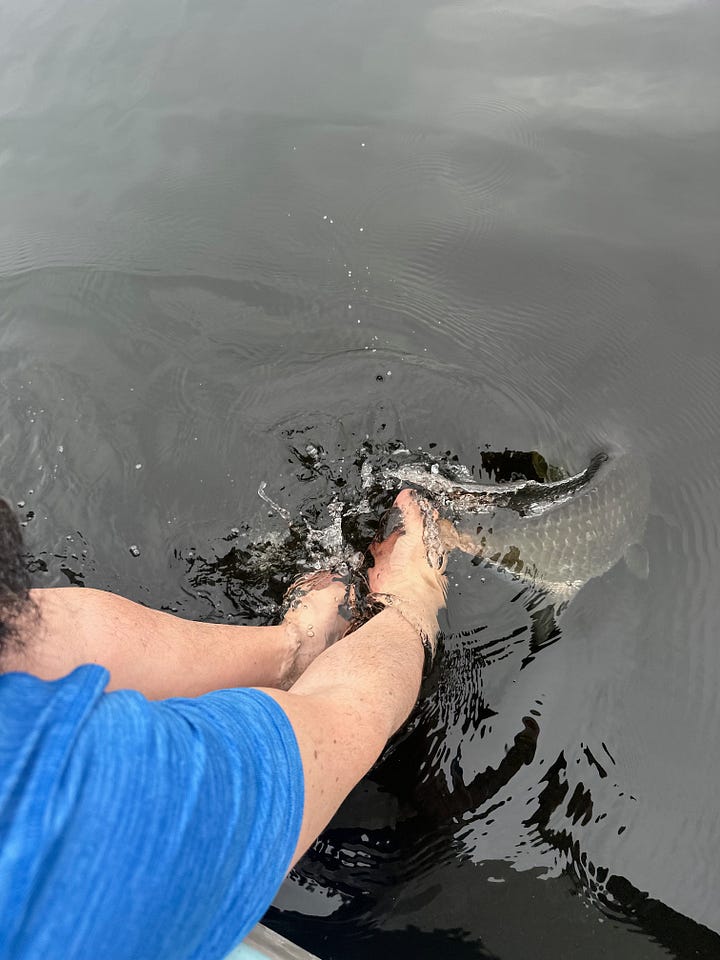
On our last day of fishing, after passing Cabeza de Vaca and the Mayan ruins, after my blown shot at the big snook, we finally turned off the muddy flowing main river and into a crystal clear side channel that had been dredged perfectly straight for a couple miles. Hundreds of small tarpon were rolling at the confluence in the mudline but we motored past them. We motored past single men in small boats handlining for mojarra along the banks, also known as the Mayan cichlid, apparently the most sought after table fare here, though difficult to get locally in restaurants. I forget why.
We motored past an oil well that was drilled on New Year’s eve in 1971. It is 3,000 meters deep. Tabasco is the center of Mexico’s oil and gas industry and there used to be direct flights between Villahermosa and Houston, but now you have to connect through Mexico City. This side channel was dredged for oil and gas development and immediately past the wellhead the creek regains its meanders and creeps up through a vast tangled mat of floating plants until it opens into a huge lagoon, many times the size of La Cometa but without any trees surrounding it, just the vast, flat landscape of suspended aquatic plants. There were fish rolling in the lagoon but Paco said we coudn’t fish it, “it is Salsipuedes” - literally “leave if you can.” Apparently this is the watery backdoor into a small, remote enclave called Salsipuedes where they do not take kindly to outsiders.
Paco said that if we went into the lagoon some guys would come on a boat and make us pay them money and they are not the kind of people you want to meet. It is a place for people who don’t want to be found, “some oil workers, sicarios, families,” Paco said. I laughed nervously.
We spent the next three or four hours fishing just the meandering section of this deep, surprisingly fast moving creek from the lagoon to the wellhead. Only five hundred or so yards long, but every bend was loaded with tarpon and they were mostly of decent size. We also caught mojarra and tenguayaca (Petenia splendida). Tenguayaca is a type of cichlid with a wildly extensible jaw and we caught them in La Cometa, too. We saw monkeys in a small patch of forest on a rise. A strong cold front was moving in and the wind blew hard and it rained hard and Paco called it “ice fishing” as the temperature dipped into the high seventies. Later that day as we approached the boat launch there were big rollers coming into the river from the Gulf of Mexico.
I caught my biggest fish of the trip here and it wasn’t really that big, but I was happy with it and also proud of not trout setting it, in fact I was proud of a really textbook strip set, and I told Paco this and he answered, “yeah, these bigger fish just grab it and hook themselves, anyone can hook them.” I looked at him wide-eyed - “come on dude!”
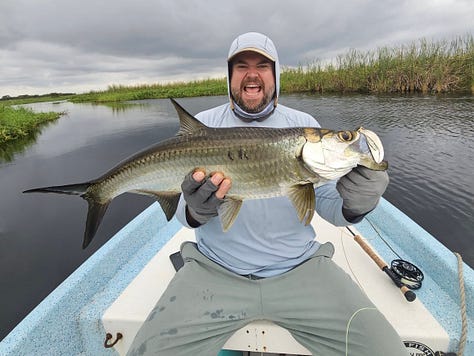
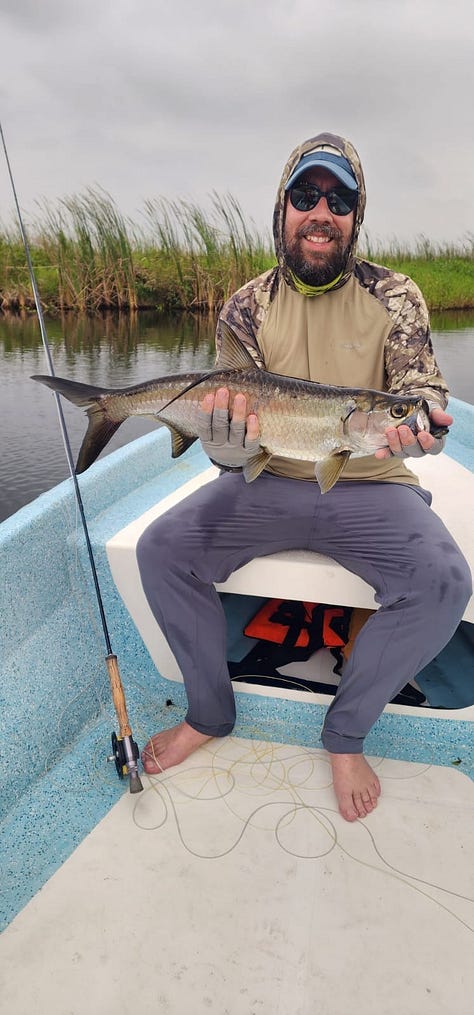
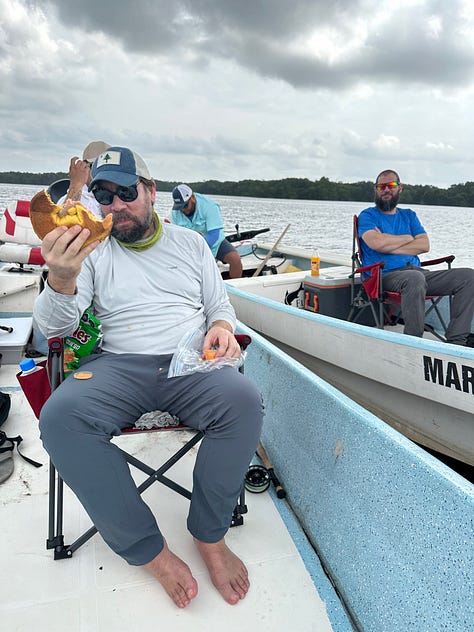
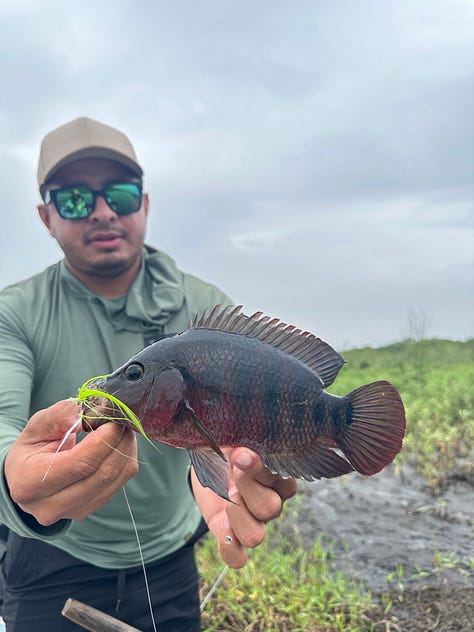
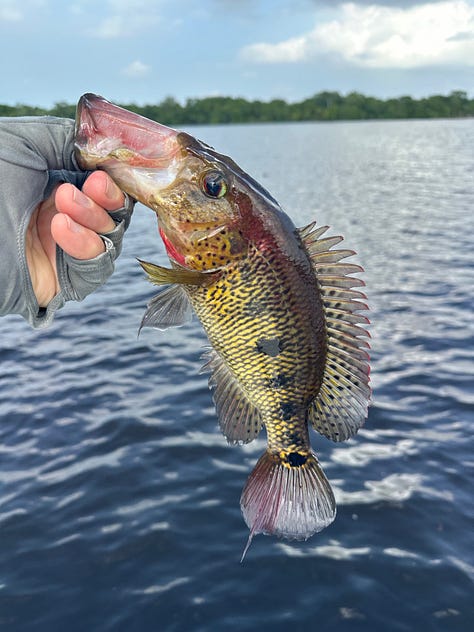
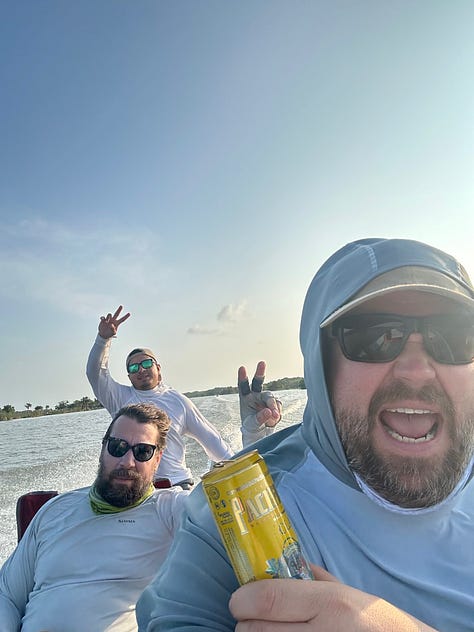
Before flying out to Mexico City the next day Paco dropped us at El Teapaneco in Villahermosa for a final savage Mexican breakfast. Mexican breakfasts really deserve their own dedicated story of praise and awe, of wide eyed gaping at their viciousness, their power, their endless combinations of tortillas and cheese, refried beans, the unholy union of eggs and chicken (as Ryan noted: “wiping out an entire chicken family lineage”), of various salsas, of cured and fried meats. Ryan claimed that Mexico recently overtook the US as the fattest country in the world and I can certainly see how that could happen on breakfast alone, but I can’t find any confirmation of this claim on the internet.
I had the Huevos Tigrones - a stack of tostadas layered with refried beans, two fried eggs, a pile of chicharrón castacán con carne, all drowned in a rich tomato based chipotle sauce, served with a side of fried plantains and topped with raw red onions and some sort of crispy fried long-shredded vegetable and a perfectly charred green habanero. Of course I ordered the side of cochinita pibil because it was offered. This mass of shredded pork pulsed in its ramekin with slick fat and intense flavor, a rubenesque siren set on seducing my aorta.
We were spending the night in Mexico City before heading home and had decided on a final, opulent, city-based “day of consumption” (not pulmonary tuberculosis) to celebrate a successful trip, inspired largely by breakfast, so of course we had some beers at the airport and then had some more on the plane but they made little impact on our heavy morning meal. I’ve also included a pic of a chilaquiles from the Frontera breakfast spot (note green veggie fiber blast in back - with nopal and pineapple) and a couple food pics from Mexico City: some tacos and an awesome blue crab tostada with habanero foam - the other is with octopus.
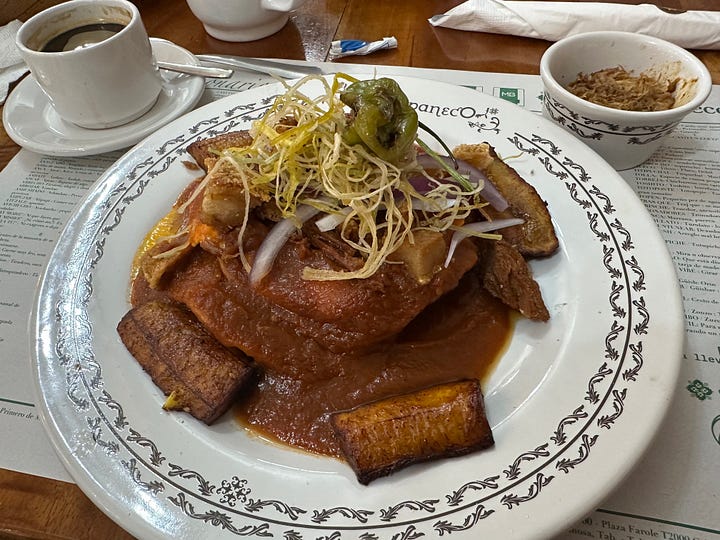
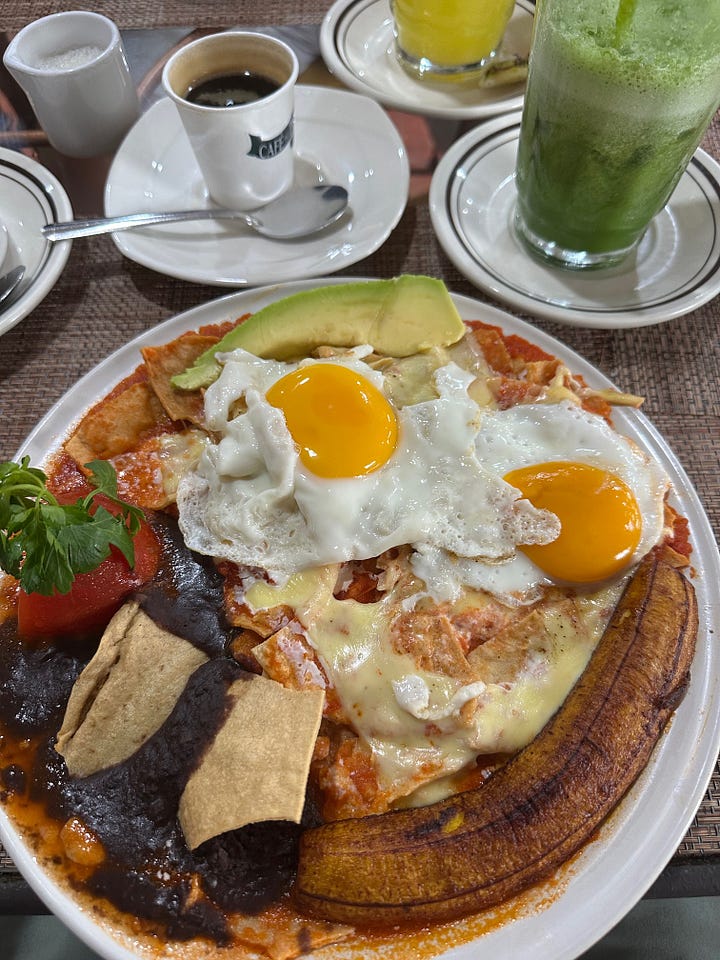
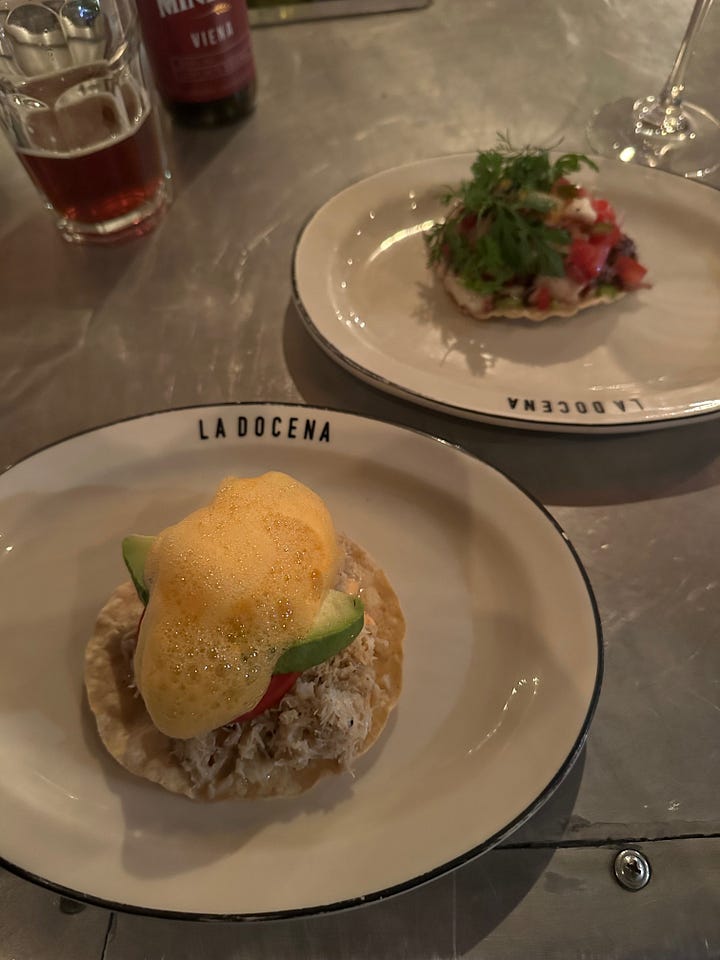

The skies were clear and the short flight from Villahermosa to Mexico City took us just to the south of the highest mountains in Mexico - impressively massive active volcanoes that protrude corpulently, and well organized, into the sky. They are almost roundly symmetrical, bosomly, in fact, down to their craggy areolas. They were rimmed concentrically in snow, jagged rock, and finally green forest. We first encountered Pico de Orizaba, the highest mountain in Mexico and the third highest peak and the highest volcano in all of North America at 18,471’. Then about ninety miles further west we passed by Popocatépetl and Iztaccihuatl, both over 17,000’. These two are connected by a rocky saddle and both were furnished with small puffs of white clouds invisibly tethered to their eastern leeward flanks.
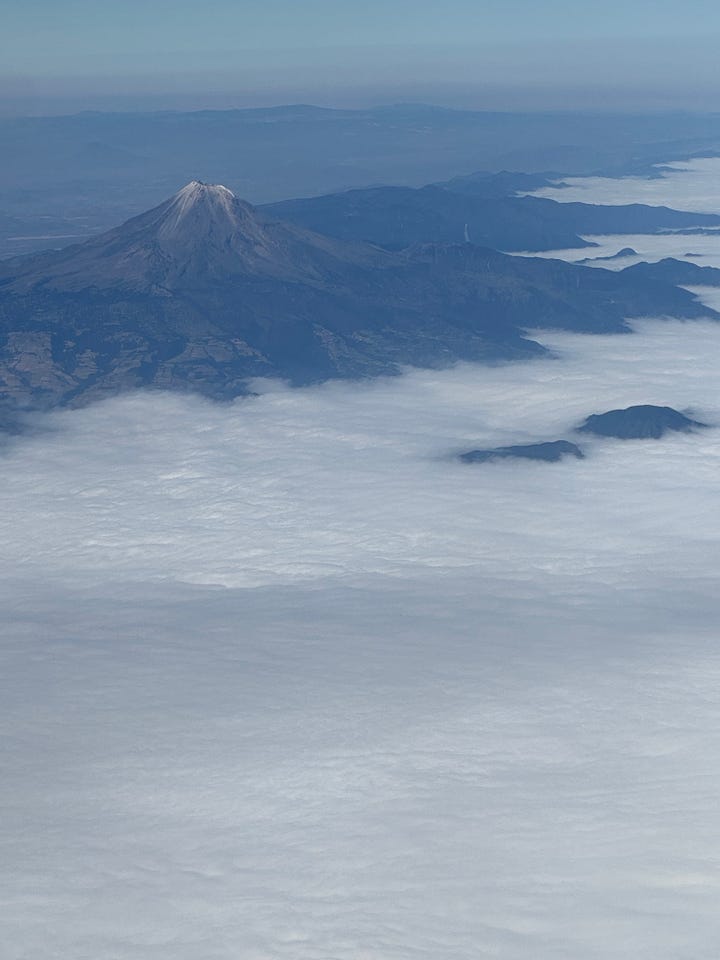
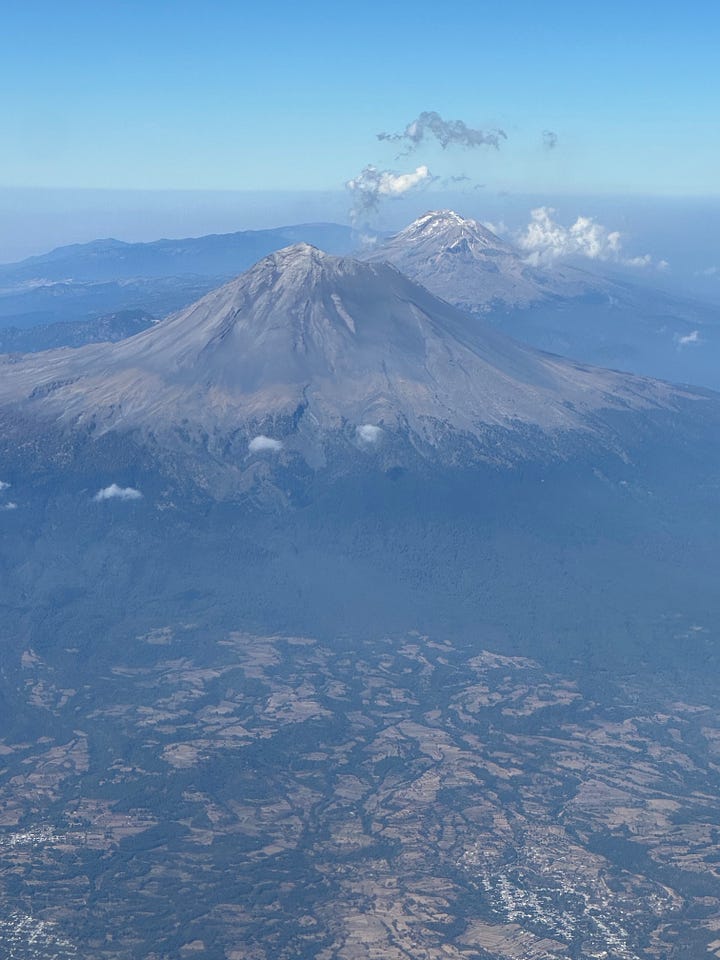
Y Paco, un tiempo mas, gracias por un viaje que bueno.

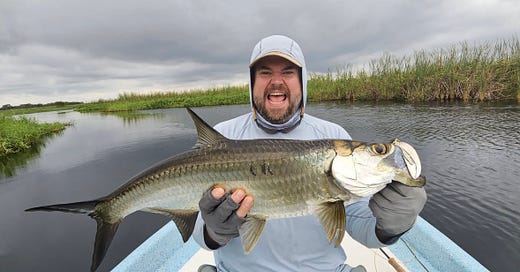


Mexican breakfast and tenguayaca (!!!crazy!!!) and tarpon on gurglers… bien as hell.